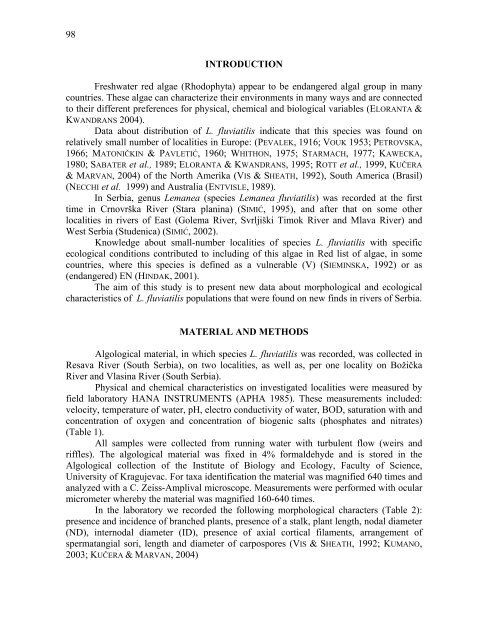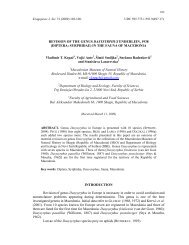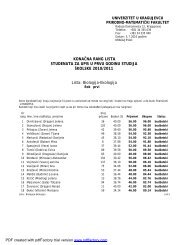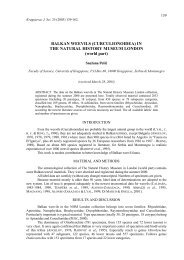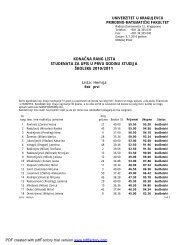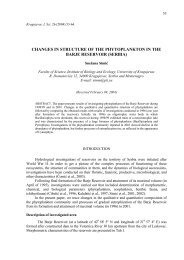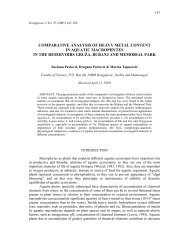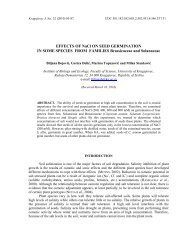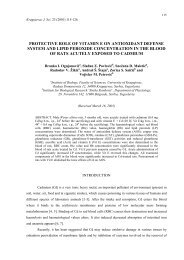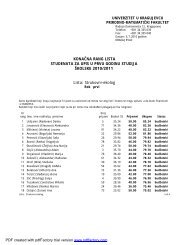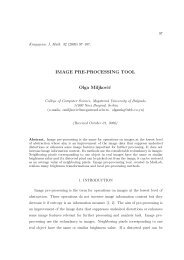morphological and ecological characteristics of rare
morphological and ecological characteristics of rare
morphological and ecological characteristics of rare
Create successful ePaper yourself
Turn your PDF publications into a flip-book with our unique Google optimized e-Paper software.
98<br />
INTRODUCTION<br />
Freshwater red algae (Rhodophyta) appear to be endangered algal group in many<br />
countries. These algae can characterize their environments in many ways <strong>and</strong> are connected<br />
to their different preferences for physical, chemical <strong>and</strong> biological variables (ELORANTA &<br />
KWANDRANS 2004).<br />
Data about distribution <strong>of</strong> L. fluviatilis indicate that this species was found on<br />
relatively small number <strong>of</strong> localities in Europe: (PEVALEK, 1916; VOUK 1953; PETROVSKA,<br />
1966; MATONIČKIN & PAVLETIĆ, 1960; WHITHON, 1975; STARMACH, 1977; KAWECKA,<br />
1980; SABATER et al., 1989; ELORANTA & KWANDRANS, 1995; ROTT et al., 1999, KUČERA<br />
& MARVAN, 2004) <strong>of</strong> the North Amerika (VIS & SHEATH, 1992), South America (Brasil)<br />
(NECCHI et al. 1999) <strong>and</strong> Australia (ENTVISLE, 1989).<br />
In Serbia, genus Lemanea (species Lemanea fluviatilis) was recorded at the first<br />
time in Crnovrška River (Stara planina) (SIMIĆ, 1995), <strong>and</strong> after that on some other<br />
localities in rivers <strong>of</strong> East (Golema River, Svrljiški Timok River <strong>and</strong> Mlava River) <strong>and</strong><br />
West Serbia (Studenica) (SIMIĆ, 2002).<br />
Knowledge about small-number localities <strong>of</strong> species L. fluviatilis with specific<br />
<strong>ecological</strong> conditions contributed to including <strong>of</strong> this algae in Red list <strong>of</strong> algae, in some<br />
countries, where this species is defined as a vulnerable (V) (SIEMINSKA, 1992) or as<br />
(endangered) EN (HINDAK, 2001).<br />
The aim <strong>of</strong> this study is to present new data about <strong>morphological</strong> <strong>and</strong> <strong>ecological</strong><br />
<strong>characteristics</strong> <strong>of</strong> L. fluviatilis populations that were found on new finds in rivers <strong>of</strong> Serbia.<br />
MATERIAL AND METHODS<br />
Algological material, in which species L. fluviatilis was recorded, was collected in<br />
Resava River (South Serbia), on two localities, as well as, per one locality on Božička<br />
River <strong>and</strong> Vlasina River (South Serbia).<br />
Physical <strong>and</strong> chemical <strong>characteristics</strong> on investigated localities were measured by<br />
field laboratory HANA INSTRUMENTS (APHA 1985). These measurements included:<br />
velocity, temperature <strong>of</strong> water, pH, electro conductivity <strong>of</strong> water, BOD, saturation with <strong>and</strong><br />
concentration <strong>of</strong> oxygen <strong>and</strong> concentration <strong>of</strong> biogenic salts (phosphates <strong>and</strong> nitrates)<br />
(Table 1).<br />
All samples were collected from running water with turbulent flow (weirs <strong>and</strong><br />
riffles). The algological material was fixed in 4% formaldehyde <strong>and</strong> is stored in the<br />
Algological collection <strong>of</strong> the Institute <strong>of</strong> Biology <strong>and</strong> Ecology, Faculty <strong>of</strong> Science,<br />
University <strong>of</strong> Kragujevac. For taxa identification the material was magnified 640 times <strong>and</strong><br />
analyzed with a C. Zeiss-Amplival microscope. Measurements were performed with ocular<br />
micrometer whereby the material was magnified 160-640 times.<br />
In the laboratory we recorded the following <strong>morphological</strong> characters (Table 2):<br />
presence <strong>and</strong> incidence <strong>of</strong> branched plants, presence <strong>of</strong> a stalk, plant length, nodal diameter<br />
(ND), internodal diameter (ID), presence <strong>of</strong> axial cortical filaments, arrangement <strong>of</strong><br />
spermatangial sori, length <strong>and</strong> diameter <strong>of</strong> carpospores (VIS & SHEATH, 1992; KUMANO,<br />
2003; KUČERA & MARVAN, 2004)


